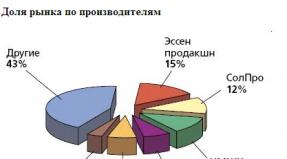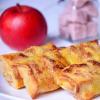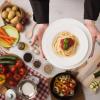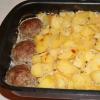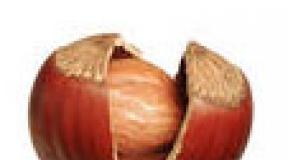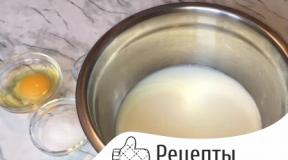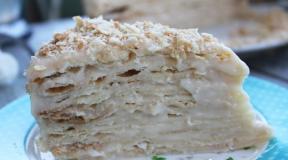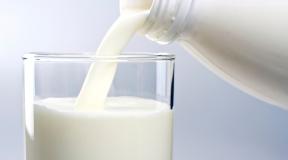How many calories are in cooked foods table. How to count calories to lose weight
Calories are the energy that the body receives from food, and then spends on any action. A person eats food, and the body uses them to generate energy, which then provides the organs of life. Energy is needed for the work of all vital processes: mental work, breathing, heat exchange, heartbeat, and even for movement. Each product has a specific chemical composition, but they all consist of the same substances, but in different proportions. So, the components are:
- carbohydrates;
- trace elements;
- proteins;
- water;
- vitamins;
- fats.
Why count calories
Not observing the diet, a person tends to exceed the daily calorie intake, and even if he does not eat too much, because the calorie content of all foods is different. Snacks that are not considered complete meals are swallowed and forgotten. In addition, calories are divided into "harmful" and "healthy". Eating an unlimited number of them, women have a desire to lose weight with the help of diets, the essence of which is the same - a decrease in daily calorie intake.
All diets have a common significant drawback - a limited list of foods. Even if you followed a strict diet for weight loss and achieved the desired result, you still have not abandoned your previous eating habits, so they will quickly "spoil" your slimness. Calculating the energy value of foods and the amount of food consumed should not become a temporary diet for you, but a way of life - only constant control and a table will help you always have a beautiful figure and be healthy.
How to count
If you decide to switch to PP and use a calorie counting table for weight loss in everyday life, get a diary in which you will record your achievements. While observing the daily calorie intake, write down each food that you ate during the day, and also set aside a place where you will keep a record of physical activity. The third column of the table will show your weight changes - you need to record your morning weight in a weight loss journal.
By comparing the results of losing weight, you can adjust your diet. At the same time, focus on the minimum required by the body, and keep in mind that in order to lose weight, it must burn more calories than it received. The required amount is calculated individually for everyone, because it takes into account the state of the body, the age of losing weight, and his physical activity. For example, a woman who does not exercise much can eat 2200 kcal per day, for men whose activities are not related to physical activity, the number increases to 2800 kcal / day.
For weight loss, counting needs to be done a little differently, reducing the permissible daily calorie intake:
- women who are not involved in sports need 1000-1200 kcal / day to lose weight, men 500-600 kcal more;
- women involved in training should consume 2000-2200 kcal per day, men need to add 500 kcal to this number.
How to count calories correctly to lose weight - table
When deciding to reduce your body weight, you need to control your intake of high-calorie meals. The calorie table of slimming products will become your faithful assistant in drawing up the menu, but you need to take into account other points:
- The calorie content of water, tea and coffee is zero, but this does not include sugar, honey, milk or other additional ingredients that you decide to add to the drink.
- When preparing a complex dish, keep in mind that in order to calculate its energy value, you need the energy value of the products included in the composition.
- When frying, add the calorie content of the oil in which it is fried to the calorie content of the product.

Calorie table of food
Knowing your permissible daily calorie intake for weight loss, you can correct your menu and correctly compose a diet. The calorie counting table for weight loss will help you with this - thanks to it you will find out the composition of the BJU and the calorie content of food, which are considered the most popular and accessible to everyone. In the table, data on calorie content and composition are displayed per 100 g of product.
| Product name | Calories (kcal) | Carbohydrates |
||
| Berries, fruits |
||||
| Orange | ||||
| Cowberry | ||||
| Grape | ||||
| Grapefruit | ||||
| Strawberry | ||||
| Gooseberry | ||||
| Mandarin | ||||
| Currant | ||||
| Greens, vegetables |
||||
| Eggplant | ||||
| Green peas | ||||
| White cabbage | ||||
| Broccoli | ||||
| Brussels sprouts | ||||
| Cauliflower | ||||
| Red cabbage | ||||
| Sauerkraut | ||||
| Boiled potatoes | ||||
| Potato | ||||
| Fried potato | ||||
| Onion | ||||
| Green onion | ||||
| Red onion | ||||
| Pickled cucumber | ||||
| Fresh cucumber | ||||
| Parsley | ||||
| Sweet pepper | ||||
| Celery | ||||
| Red beans | ||||
| White beans | ||||
| Walnut | ||||
| Cedar nut | ||||
| Pistachios | ||||
| Ostrich egg | ||||
| Quail egg | ||||
| Chicken egg | ||||
| Dried mushrooms | ||||
| Mushroom white | ||||
| Fried mushrooms | ||||
| Raincoats | ||||
| Aspen boletus | ||||
| Boletus | ||||
| Dried foods |
||||
| Prunes | ||||
| Dried apples | ||||
| Cheese, dairy products | ||||
| Bryndza cow | ||||
| Yogurt 1.5% | ||||
| Whole milk | ||||
| Milk 3.2% | ||||
| Ryazhenka 6% | ||||
| Yogurt | ||||
| Cream 20% | ||||
| Cream 10% | ||||
| Sour cream 20% | ||||
| Sour cream 10% | ||||
| Parmesan | ||||
| Dutch cheese | ||||
| Lambert cheese | ||||
| Russian cheese | ||||
| Processed cheese | ||||
| Sausage cheese | ||||
| Curd cheese | ||||
| Cottage cheese 18% | ||||
| Low-fat cottage cheese | ||||
| Bakery products |
||||
| Rye flatbread | ||||
| Butter baked goods | ||||
| Wheat bread | ||||
| Bread Darnitsky | ||||
| Rye bread | ||||
| Cereals, legumes, flour |
||||
| Green peas (canned) | ||||
| Green peas (fresh) | ||||
| Dried green peas | ||||
| Rye flour | ||||
| Wheat flour | ||||
| Pearl barley | ||||
| Wheat groats | ||||
| Barley grits | ||||
| Cornflakes | ||||
| Pasta | ||||
| Oat flakes | ||||
| Lentils | ||||
| Barley flakes | ||||
| Seafood |
||||
| Chum caviar | ||||
| Granular caviar | ||||
| Pollock roe | ||||
| Fried carp | ||||
| Canned fish in its own juice | ||||
| Canned fish in oil | ||||
| Shrimps | ||||
| Smoked salmon | ||||
| Fried salmon | ||||
| Seaweed | ||||
| Atlantic herring | ||||
| Sprats in oil | ||||
| Meat products |
||||
| Brisket | ||||
| Roast beef | ||||
| Beef stew | ||||
| Smoked sausage | ||||
| Boiled sausage | ||||
| Rabbit meat | ||||
| Boiled chicken | ||||
| Fried chicken | ||||
| Beef liver | ||||
| Pork chop | ||||
| Pork stew | ||||
| Sausages | ||||
| Veal | ||||
| Fats, sauces |
||||
| Melted fat | ||||
| Creamy mayonnaise | ||||
| Margarine sandwich | ||||
| Baking margarine | ||||
| Creamy margarine | ||||
| Light mayonnaise | ||||
| Ghee butter | ||||
| Corn oil | ||||
| Sunflower oil | ||||
| Butter | ||||
| Soybean oil | ||||
| Olive oil | ||||
Calculator
The calorie table helps, but many people find it tedious to use it. For this reason, those who are losing weight should consider in more detail a guide indicating the calorie content of ready-made meals, or popular online calculators. Electronic counters can be used not only to count calories, but also BJU, vitamins and minerals in a certain dish. An online program helps to calculate how many useful components meat, vegetables, fish or fruits lose when cooked.
Calculating the daily calorie intake for weight loss
How many calories you can consume per day can be calculated simply. You just need to multiply the value of your weight in kg by 24 - the resulting number will be the rate of calorie consumption for an organism at rest (due to this amount of energy, it will ensure the work of processes necessary for a person's life). Even when calculating the daily calorie content for weight loss, you need to take into account the recommended dose of BJU: the menu for the day should consist of 20% fat, 40% carbohydrates and 40% protein.

Physical activity ratio
The amount of daily calorie intake depends on how active the person is. In this case, the number of the permissible norm must be multiplied by a coefficient expressing motor physical activity. This indicator has an average value:
- 1.2 - for people who are very overweight or lead a completely inactive lifestyle;
- 1.4 - for those who go in for sports at least 3 times / week;
- 1.6 - for people working in the office and those who rarely burden themselves with physical labor;
- 1.5 - for those who exercise daily and are engaged in physical labor.
Base metabolic rate
A calorie counting chart can help you lose weight, but there are other values to consider to calculate your daily calorie intake. So, to maintain weight, your base metabolic rate must be multiplied by your activity ratio. To lose weight, the daily rate must be reduced: for women up to 1200 kcal, for men - up to 1800 kcal. To lose weight, you need to either reduce your calorie intake by reducing the amount of food, or increase your physical activity. It is worth noting that before increasing the load while losing weight, you need to calculate how many calories you can eat before training.
Calorie Diet
For those who have problems with weight, nutritionists have developed a special system - calculating the calorie content of the foods consumed according to the table. Sitting on this diet, you do not need to give up your favorite tasty dishes, because the scheme of the system is as simple as possible - you just need to reduce the number of portions and their volume. Reviews about such a diet suggest that in a month you can easily lose from 4 kg of excess weight (depending on the initial weight). The diet is absolutely safe for health, provided that you do not reduce your daily calorie intake below the minimum threshold of 1200 kcal.
A calorie-based diet will not make you hungry. You will be convinced of this by looking at its sample menu:
- breakfast - 200 g of salad (fresh cabbage and carrots), seasoned with 0.5 tsp. vegetable oil, a piece of boiled sausage (50 g) or chicken cutlet, bread and unsweetened tea;
- snack - 100 g of citrus jelly, a glass of lemon jelly;
- lunch - 150 g of bean soup, 150 g of roast vegetables with pork, a cup of mountain ash tea, 100 g of potato cookies;
- afternoon tea - a glass of kvass made from the extract, 2 loaves of bread, covered with a thin layer of apricot jam;
- dinner - 100 g of buckwheat, 100 g of boiled chicken fillet, a cup of tea with an apple;
- at night - a glass of fat-free kefir.

How to Choose Calorie Diet Recipes
A weight loss chart may not help you achieve your goal if you systematically break the rules. So, having gathered to count calories, you should:
- Limit your fat intake. Animal fat is twice as high in calories as carbohydrates. If the menu contains no more than 30% fat, then the body does not require an increase in the dose of carbohydrates and protein, due to this, the calorie content of the diet becomes 10% less.
- Minimize your sugar intake. Any type of sugar or its substitute increases appetite, which is why a person overeats, which is unacceptable for losing weight. A healthy menu should contain no more than 20 g of sugar / day.
- Increase the intake of fiber (it is found in cereals, fruits, vegetables) and pectins. This kind of food is the best for losing weight - it is absorbed more slowly and satiates faster.
Video
- Nastya
:
- Denis S.
:
Thank you very much for the food calorie tables, I will also support Nastya - it would be great to add the ability to download them in Word or PDF format.
- Julia
:
What a useful sign. I didn't know that cornflakes are so high in calories, but I eat them every day and wonder why the extra pounds don't go away. Now I will revise my diet. I will take away some of the products.
- Pauline
:
Wow, how everything is in detail. It's strange that I've never seen anything like it before. But it is very convenient, especially for those people who monitor their health and their weight. Perhaps I also save it to bookmarks.
- Alina
:
What a great and detailed sign! I want to print it and hang it in the kitchen, because sometimes I want to eat something forbidden, but at least I will know how many calories there are and I will think twice if there are.
- Dina
:
Tell me, in the morning I eat oatmeal with milk, nuts and dried fruits, while I want to lose weight ... I stick to a diet. Can I replace my breakfast with something else, as I understand it, based on the table, is it high in calories?
- Julia
:
How do I know your calorie chart is correct? For example, I have slightly different data on the number of calories in foods, and I took my table from the site, where they also said that they had the most correct table, and that using it, many people lost weight. So who should you believe? Or should you try, first that one, and then yours, or vice versa?
- Valeria
:
For some reason, I always thought that mayonnaise is much more high-calorie. Competent table, now it's easier to control the diet. I immediately found my mistakes, I will take into account for the future. And I will not give up my favorite bananas, you can afford one a day!
- Olya
:
I only monitored the calorie content for the first 3 days of the diet, then I stopped, since it was already clear how many calories are in my breakfast, lunch or dinner. Moreover, there are a lot of applications that everyone calculates themselves.
- Sonya
:
I quite often look at such tables, of course, the number of calories is approximate, not accurate, but at least I know that I ate a little and my lunch or dinner did not affect my figure.
- Dasha
:
Sometimes you just wonder how many calories are in a particular product. During the period of the diet, that table generally needs to be printed and hung on the refrigerator, to highlight the most high-calorie foods.
- Sasha
:
Knowing the calorie content of foods is necessary, especially if you are trying to keep track of your figure. You need to at least roughly understand what part of the daily norm you ate.
- Rita
:
Once again I go on a diet and this time everything will be serious, I downloaded and printed out the calorie tables, put them on the refrigerator and I will count calories, once again I am convinced that diets do not work, only counting calories, with their lack of fat begins to melt ...
- Eve
:
I advise everyone to download the calorie counting app for convenience. There are a huge number of them. You don't need to keep everything in your head, carry a cheat sheet with you. You bring in groceries, like lunch, and you're done.
- Kristina
:
Thank you for such high-quality and detailed tables, now it will be very easy for me to calculate the correct diet in order to effectively start losing my excess weight!
- Maria
:
And I was surprised that there are no carbohydrates in meat, nor in fish. And what fatty caviar !!! Do not get carried away for sure, it is also salty - it can hold water. With such a useful table, I learn a lot about products.
- Anna
:
I didn't know before that counting calories is so important for losing weight. I thought I should go on a diet and try to starve. And the greater effect is just with proper nutrition - this plate is now to help me.
- Angelica
:
From my own experience, I will say that losing weight should start by studying the tables of calorie content of products, and even better, print it and a story on the refrigerator. Sometimes it seems to us that there are few calories in the product, we eat without measure, as a result, all this is deposited in fat, since the calories began to be counted, so the weight went down and all this without diets, I just eat in moderation, observing the recommended calorie intake.
Probably, now there is no such person who would not hear the word "calorie". But not everyone understands what exactly it means. The term was first introduced by Swedish physicists back in the 18th century and was used to define the heat of combustion of a fuel. Now the concept of "calorie" is used in utilities and energy, as well as to denote the value of products. The word acquired the greatest popularity in the latter sense. Calories in foods are the amount of energy that has entered the body when they are digested and fully absorbed. A person spends it on maintaining the work of his body, on daily activities, and spends it constantly, even in a dream. This energy is usually determined in kilocalories (abbreviated - kcal). It is also possible to count in kilojoules (kJ), which are similar units of measurement.
Calories in food
It is the energy contained in food products that is of the greatest interest. In production, their exact value is measured in a special device, a calorimeter, by burning in its sealed chamber. The amount of heat released during this is the energy value. Thus, the manufacturer determines how many calories are in food. To inform buyers, this value is applied to the packaging in which the product will be sold. The number of calories in foods is usually indicated per 100 grams of weight.
Food and weight
Having found out that calories in foods are energy supplied to the body, it is not so difficult to understand that its excess can lead to gaining excess body weight. But nutritional value is also important, that is, the amount of carbohydrates, fats and proteins. These concepts are interconnected. It is not for nothing that it is believed that excessive consumption of fatty and sweet (high-carbohydrate) foods leads to weight gain. Just look at the calories in foods. The 100 gram table for carbohydrates, fats and proteins is shown below.
That is why the labels indicate not only the energy, but also the nutritional value of the products. Knowing how many calories are in foods, the amount of carbohydrates, proteins and fats, it is easy to lose or increase body weight. It is enough just to determine your correct weight and the dose of energy and nutrients necessary for the body.
Calories in foods, table per 100 grams
Keeping track of your diet, the energy value of the diet is a good habit for a person leading a healthy lifestyle and keeping fit. Counting food calories is easy, and you don't have to memorize each product's label information. It is enough to use the already accumulated knowledge. They can easily answer the question of how many calories are in foods. A table of basic food items with average values is shown below. The number of calories per 100 g of product is shown in the second column, proteins - in the third, fats - in the fourth, carbohydrates - in the fifth.
Unsweetened bakery products

Simple loaf | ||||
Bran loaf | ||||
Unsweetened bun | ||||
Borodinsky bread | ||||
Whole grain bread | ||||
White wheat bread | ||||
Bran bread | ||||
Rye bread | ||||
Confectionery and baked goods

Sugar dragee ("Sea stones", etc.) | ||||
Marshmallow white | ||||
Caramel (lollipops) | ||||
Caramel (stuffed) | ||||
Fondant candies | ||||
Chocolate sweets | ||||
Marmalade | ||||
Glazed cookies | ||||
Cookies with nuts | ||||
Butter cookies | ||||
Chocolate cookies | ||||
Puff pastry | ||||
Biscuit cake | ||||
Shortbread cake | ||||
Yeast pastry (buns) | ||||
Cornflakes | ||||
Baked goods, sweets, especially those with a filling or soaked in fatty cream, have the highest energy value. It is enough to avoid them to maintain normal weight. Sugary carbonated drinks and juices are in second place in the rating of harmfulness. Calories in food, table per 100 grams, continued below.
Natural juices and carbonated drinks
Apricot juice | ||||
Pineapple juice | ||||
Orange juice | ||||
Grape juice (with apple) | ||||
Cherry juice | ||||
Pomegranate juice | ||||
Grapefruit juice | ||||
Pear juice | ||||
Peach juice | ||||
Beet juice | ||||
Plum juice | ||||
Tomato juice | ||||
Apple juice | ||||
Coca Cola and Pepsi | ||||
Gazvoda with sugar |
At first glance, it seems that the numbers are small, but since calories in foods are given per 100 grams, and drinks are consumed in much larger volumes, it is worth considering.

Oil products and sausage products are next. Their energy value is also alarming.
Mayonnaise, oils, fats
Culinary fat | ||||
Mayonnaise "Provencal" | ||||
Low calorie mayonnaise 20% fat | ||||
Margarine | ||||
Peanut butter | ||||
Sunflower oil | ||||
Olive oil | ||||
Sweet butter |
Prepared meat products
Smoked bacon | ||||
Natural ham | ||||
Sausage ham | ||||
Chicken sausage | ||||
Sausage "Doctor" | ||||
Cooked-smoked sausage | ||||
Raw smoked sausage | ||||
Sausage "Milk" | ||||
Sausages | ||||
Milk sausages | ||||
Sausages with cheese | ||||
Creamy sausages |
In general, all sausages are rich in fat, and, as a rule, its amount prevails over protein. When choosing the products of meat processing plants, it is worth paying special attention to this. The most healthy choices are chicken and beef cooked sausages. The carbohydrate group, cereals and pasta are quite useful, as they guarantee long saturation. It is important to cook them correctly, without excess fat, taking into account the calories in the products (the table for 100 grams for cereals and pasta is presented below). The weight of raw products is taken into account.
Cereals, pasta
Hercules | ||||
Corn (groats) | ||||
Durum wheat pasta | ||||
Pearl barley | ||||
Natural meat, fish and milk are the healthiest foods in the human body. They are rich in protein, which means they saturate for a long time, promote muscle development, strengthen bones and tissues.

Vegetables and fruits are also healthy. Their calorie content is low, and their taste is attractive. Having made these types the main products in your daily menu, you can maintain health for many years and forget about excess weight.

The number of calories in foods in these categories is shown below.
Milk products
Milk 0.5% | ||||
Milk 1.5% | ||||
Milk 2.5% | ||||
Milk 3.2% | ||||
Sour cream 15% | ||||
Sour cream 20% | ||||
Meat
Mutton | ||||
Beef | ||||
Beef liver | ||||
Chicken liver | ||||
Fatty pork | ||||
Lean pork | ||||
Veal | ||||
Beef tongue |
Bird
Goose carcass | ||||
Turkey carcass | ||||
Chicken liver | ||||
Chicken heart | ||||
Chicken stomach | ||||
Duck carcass | ||||
Chicken thigh | ||||
Chicken drumstick | ||||
Chicken breast | ||||
Chicken carcass | ||||
Egg, protein | ||||
Egg, yolk | ||||
Chicken egg (in 1 piece) |
A fish
Low-fat herring | ||||
Mackerel | ||||
Horse mackerel | ||||
Sea trout | ||||
Vegetables
Eggplant | ||||
White cabbage | ||||
Ripe potatoes | ||||
Corn | ||||
Green onion | ||||
Bulb | ||||
Sweet pepper | ||||
Radish red | ||||
Celery root | ||||
Green beans | ||||
Fruit
Orange | ||||
Grape | ||||
Grapefruit | ||||
Mandarin | ||||
Now you know more about the energy value of foods. Choose the right foods for your diet and stay healthy!
Modern dietetics suggests using the calorie counting method for weight loss, thanks to which a person gets the opportunity to expend more energy than consume. Calorie table for weight loss - a list of foods or ready-made meals with the number of calories calculated for them per 100 grams. They are formulated for all kinds of food, from apples to baked goods.
What is a calorie table
Excess weight is a scourge of modern women and men; every year this problem becomes more and more urgent. The calorie table of products for weight loss, which indicates the energy value of products, is designed to prevent the problem. This indicator is determined using the amount of proteins, fats and carbohydrates (BZHU), during the oxidation of which a certain amount of energy is released. The data is stored in a table of food calories, and they are used to calculate the kilocalories of food eaten during a diet.
Calorie Counting for Weight Loss
Calorie tables for foods and ready-made meals will help you lose weight when you know the daily rate, a person's need for energy. Nutritionists offer different methods to determine the exact figure. To lose weight by 1 kilogram of weight, you need to eat 7700 kcal less than burn. The food calorie table helps you create an optimal diet for weight loss.
Calorie table of products
On the Internet, there is more than one table of calories for weight loss, containing information on the energy value of vegetables, meat, fruits and other things. For successful weight loss, keep a food diary, enter everything you eat per day, use the calorie table for weight loss for this. For the convenience of users, products are divided into groups.
Calorie table for cereals, flour
| buckwheat | |
| oat flakes | |
| durum wheat flour | |
| premium flour | |
| Rye flour | |
| durum wheat pasta | |
| premium pasta |
Sausages
Milk products
| milk 2.5% | |
| milk 3.2 | |
| yogurt 1.5% | |
| yogurt 3.2% | |
| sour cream 10% | |
| sour cream 20% | |
| Dutch cheese | |
| fat cottage cheese | |
| fat-free cottage cheese |
Fruits, berries
| Orange | |
| grapefruit | |
| tangerines | |
Calorie table for ready meals
When a recipe includes many products at once, it can be difficult to calculate the energy value yourself. By combining ingredients, we add oils and sauces to them, which further complicates the calculation task. To find out the amount of energy in a plate, use the calorie table of food for weight loss, which contains the numbers for the finished recipe.

First meal
This table includes the most popular soups that are most often on our table. Please note that the data may be inaccurate due to the nature of the preparation and the vegetables, meat and cereals used in the recipe:
| chicken broth | |
| vegetable broth | |
| beef broth | |
| pork broth | |
| bean soup | |
| pickle in meat broth | |
| pea soup | |
| meat hodgepodge | |
| meatball soup | |
| lean borscht | |
| borscht with beef | |
| cabbage soup |
Second courses
The calorie table contains options for main courses. With independent calculations, one should take into account the increase or decrease in volume that occurs during cooking. The final energy value is calculated by multiplying the kcal of the raw product by the coefficient of reduction (increase) of the portion. Here's the bottom line:
| beef goulash | |
| steamed chicken cutlets | |
| fried chicken cutlets | |
| steamed fish cakes | |
| steamed pork cutlets | |
| chicken chop | |
| pork chop | |
| cabbage rolls with rice and minced meat | |
| liver stewed in sour cream | |
| steam salmon | |
| pilaf with pork | |
| fried potatoes with mushrooms | |
| dumplings with cottage cheese | |
| homemade dumplings | |
| meatballs with rice |
The nutritional value of a salad depends on the ingredients it contains. Before cooking, study the content, conduct an "analysis" of the future treat. For weight loss, it is important that there are no high-calorie foods in the list of components of the salad. Your figure will benefit from salads on the menu that contain low-calorie ingredients such as vegetables, eggs, lean meats and cheeses. To make it easier to calculate the calorie content of weight loss products, use a calorie table. It is difficult to calculate the total calorie content, because the numbers depend on the type and amount of dressing.

Porridge and side dishes
All information from the calorie table for ready meals is relative. The content of carbohydrates, proteins and fats can differ from the type of product, the characteristics of its preparation, the nuances of the recipe, and the methods of technological processing. If you add 10 grams of butter to a portion of porridge, then its calorie content will double:
Calorie table of drinks
Drinks are an integral part of the diet, so it is important to consider their energy value, which will be shown by the calorie table for weight loss. Many do not attach importance to the amount of juice or tea drunk per day and it is completely in vain. Each glass or cup can contain a lot of energy that you won't include in your calorie counter. The only drink that has zero calories is water, the rest of the liquids have a certain energy value.

Calorie table for alcoholic beverages
Calorie table for soft drinks
Video: how to count food calories
When it comes to eating or losing weight, everyone thinks about calories. They are counted, remembered, determined and, in general, they do everything so that there are no more of them than the required number. What for? Then, by exceeding their limit, we risk becoming overgrown with excess fat, and along with it, get health problems. In such cases, the calorie table of all products comes to our aid. Thanks to her, we can competently think over our diet without harming the figure and body.
Where did the word "calorie" come from? From the Latin language, of course. Translated, it means "warm". It is calories that measure energy. By eating a dish, we get a certain amount of calories. To calculate their amount, we need to know how many kcal can be contained in 100 grams of the product we use. These indicators are especially important for losing weight when a person needs constant control of his diet.
For good nutrition, which is the basis for the stable uninterrupted operation of our body, proteins, carbohydrates and fats are required. They are all expressed in calories. 1 gram of fat = 9 kcal, 1 gram of protein = 4 kcal, 1 gram of carbohydrates = 4 kcal
Knowing these data and how many calories are per 100 grams of the product, we are able to literally dazzle our figure, while not forgetting about sports and other attributes of an active healthy life.
To determine how many calories we got during a meal, from morning breakfast to evening dinner, you need to refer to the calorie table of foods. You can download it for free, print it and use it when necessary (there is a download link at the end of the article).
For convenience, I divided all products into groups according to the degree of calorie content.
"Calorie-free" products. This group includes foods with a calorie content of up to 30 kcal per 100 g. Why did I name these products that way? Read the article about. They are even sometimes called negative calorie foods 🙂
| Product | Calorie content(Kcal per 100 g) |
| Melon | 8 |
| A pineapple | 10 |
| Dogwood | 10 |
| Orange | 11 |
| Onion | 11 |
| Apricots | 12 |
| Pear | 12 |
| Watermelon | 12 |
| Celery | 12 |
| Horseradish | 19 |
| Cucumbers | 19 |
| Salad | 20 |
| Rhubarb (petioles) | 21 |
| Sorrel | 22 |
| Butterlets | 23 |
| Green onion | 24 |
| Radish | 24 |
| Lemon | 24 |
| Spinach | 24 |
| Squash | 25 |
| Chanterelles | 25 |
| Ryzhiki | 26 |
| Zucchini | 26 |
| Asparagus | 26 |
| Tomatoes | 26 |
| Cherry plum | 28 |
| Pumpkin | 29 |
| Cranberry | 29 |
| Champignon | 30 |

Low calorie foods - 30 - 70 kcal per 100 g. These foods are great for cooking. This and the previous group of products will be your very best friends when losing weight.
| Product | Calorie content(Kcal per 100 g) |
| Honey mushrooms | 31 |
| Green beans | 31 |
| Sea buckthorn | 31 |
| Skim milk | 32 |
| Green beans | 32 |
| Beef hip | 32 |
| Aspen boletus | 33 |
| Turnip | 33 |
| Blackberry | 34 |
| Beef tenderloin | 34 |
| Sweet pepper" | 34 |
| Eggplant | 34 |
| Cauliflower | 34 |
| White cabbage | 35 |
| Celery (root) | 36 |
| Blueberry | 37 |
| Ramson | 39 |
| 40 | |
| Swede | 41 |
| Radish | 41 |
| Sour cream 20% fat | 42 |
| Cloudberry | 42 |
| Mandarin | 43 |
| Carrot | 43 |
| White mushrooms | 44 |
| Cream 20% fat | 44 |
| Chicken egg (protein) | 44 |
| Dill | 45 |
| Wheat flour, premium | 46 |
| Cowberry | 46 |
| Quince | 46 |
| Wheat flour, 1st grade | 47 |
| Plum | 48 |
| Peaches | 50 |
| Mussels | 50 |
| Garlic | 50 |
| Strawberry | 52 |
| Currant | 52 |
| Apples | 52 |
| Gooseberry | 53 |
| Cherry | 53 |
| Rowan | 54 |
| Blueberry | 54 |
| Cherries | 54 |
| Beet | 54 |
| Acidophilus | 55 |
| Parsley | 56 |
| Mulberry | 57 |
| Parsnip (root) | 57 |
| Cow's milk (paste) | 59 |
| Garnet | 59 |
| Fig | 59 |
| Raspberries | 62 |
| Yogurt | 64 |
| Goat milk (raw) | 68 |
| Chicken liver | 68 |
| Persimmon | 69 |
| Cod | 69 |

Moderate calorie foods. In this group, I collected foods with a calorie content of 70 to 200 kcal per 100 g. This is perhaps the most basic group of products from which you can prepare excellent meals for a healthy and dietary diet. You cannot get fat on these products 🙂
| Product | Calorie content(Kcal per 100 g) |
| Haddock | 71 |
| Grape | 71 |
| Pollock | 72 |
| Corn flour | 74 |
| Green peas | 77 |
| Chicken heart | 78 |
| River perch | 82 |
| Sturgeon | 83 |
| Zander | 84 |
| Pike | 84 |
| Potato | 84 |
| Low-fat cottage cheese | 85 |
| Beef kidney | 86 |
| Acne | 90 |
| Bananas | 94 |
| Shrimps | 95 |
| Beef heart | 96 |
| Veal category 1 | 97 |
| Saury | 100 |
| Beef liver | 105 |
| Bream | 105 |
| Pork liver | 109 |
| Squid | 110 |
| Carp | 112 |
| Chicken fillet | 113 |
| Horse mackerel | 115 |
| Tuna | 136 |
| Pork tenderloin | 142 |
| Chicken stomach | 144 |
| Pink salmon | 147 |
| Bold cottage cheese | 156 |
| Chicken egg (white and yolk) | 157 |
| Quail egg | 168 |
| Beef tongue | 173 |
| Rabbit meat | 183 |
| Chicken leg | 185 |
| Mackerel | 191 |
| Lamb hip part | 198 |
High calorie foods- 200 - 450 kcal per 100 g. These are not forbidden foods, but you should not overeat them.
| Product | Calorie content(Kcal per 100 g) |
| Lamb 1 category | 209 |
| Category 1 beef | 218 |
| Fat cottage cheese | 229 |
| Beef brisket | 234 |
| Pork legs | 234 |
| Chickens of the 1st category | 241 |
| Fresh herring | 246 |
| Barley flour | 249 |
| Lamb loin | 257 |
| Prunes | 272 |
| Category 1 turkeys | 276 |
| Dried apricots | 284 |
| Lamb brisket | 288 |
| Dried apricots | 290 |
| Raisin | 296 |
| Peeled rye flour | 297 |
| Dates | 298 |
| Barley grits | 303 |
| Pork hip | 305 |
| Semolina | 307 |
| Seeded rye flour | 309 |
| Beans | 320 |
| Wheat flour, 2nd grade | 320 |
| Lentils | 321 |
| Pearl barley | 342 |
| Corn grits | 344 |
| Long grain rice | 346 |
| Chicken egg (yolk) | 350 |
| Buckwheat | 352 |
| Millet | 353 |
| Meat pork | 354 |
| Oatmeal | 361 |
| Pork loin | 383 |
| Soy flour | 384 |



